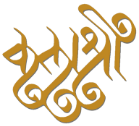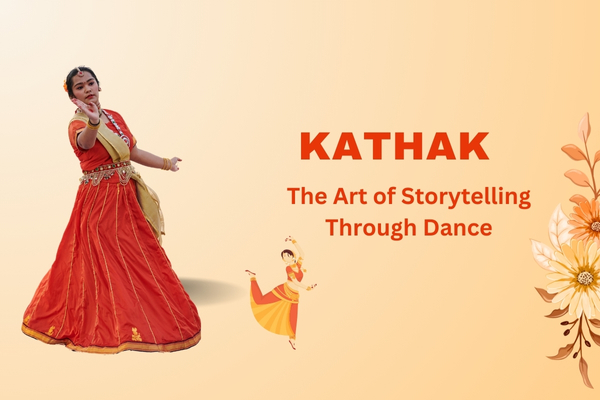Kathak, a classical dance form that originated in Northern India, is widely celebrated for its intricate footwork, graceful hand movements, and masterful storytelling. The name “Kathak” is derived from the Sanskrit word “Katha,” meaning story, and “Kathakar,” meaning storyteller. This dance form seamlessly blends rhythm, movement, music, and drama to tell stories, often from ancient Indian epics like the Mahabharata and Ramayana. This blog explores the rich tradition of Kathak as a storytelling art, delving into its history, techniques, and contemporary relevance.
Which Elements Were Used in Kathak to Tell Stories?
1. Footwork (Tatkaar)
One of the most striking features of Kathak is its intricate footwork, known as “tatkaar.” Dancers wear ghungroos (ankle bells) that accentuate the rhythmic patterns tapped out by their feet. The footwork is performed with precision, and the complexity of the patterns increases with the dancer’s proficiency. The tatkaar forms the foundation of Kathak, showcasing the dancer’s control and rhythmic mastery.
2. Spins (Chakkars)
Chakkars, or spins, are another hallmark of Kathak. Dancers execute multiple spins with remarkable speed and balance, often in synchronization with the beats of the music. The ability to perform chakkars effortlessly is seen as a testament to the dancer’s skill and training. These spins add dynamism and visual appeal to the performance.
3. Hand Gestures (Mudras)
Mudras are symbolic hand gestures used in Kathak to convey specific meanings and emotions. There are numerous mudras, each representing different objects, actions, or feelings. For example, the “Pataka” mudra, where the fingers are held straight and close together, can symbolize the wind, a forest, or a king. These gestures are essential for storytelling, as they help narrate the plot and depict characters.
4. Facial Expressions (Abhinaya)
Abhinaya (facial expressions), are crucial in Kathak for portraying emotions and narratives. Dancers use their eyes, eyebrows, and facial muscles to express a range of emotions, from joy and love to anger and sorrow. The subtlety and intensity of abhinaya enhance the storytelling aspect of Kathak, allowing the audience to connect with the characters and the storyline.
5. Costumes and Makeup
The traditional costume for female Kathak dancers includes a lehenga (long skirt), choli (blouse), and dupatta (scarf). Male dancers typically wear an angarkha (a long, flowing tunic) and churidar (tight-fitting trousers). The costumes are often adorned with intricate embroidery and mirror work, adding to the visual splendor of the performance. Makeup is used to accentuate the eyes and facial features, helping to convey emotions more effectively.
What is the Story Telling in Kathak?
Epic Narratives
Kathak performances often draw from ancient Indian epics such as the Mahabharata and Ramayana. These stories are rich in drama, emotion, and moral lessons. Dancers depict scenes from these epics, bringing the characters and events to life through their movements, expressions, and gestures. For instance, a Kathak performance might include the tale of Lord Krishna and Radha, showcasing their divine love and playful interactions.
Mythological Stories
In addition to epics, Kathak also explores various mythological stories. These include tales of gods and goddesses, demons, and celestial beings. Through Kathak, dancers convey the grandeur and mysticism of Indian mythology, enchanting audiences with stories of creation, heroism, and devotion.
Historical and Folklore Narratives
Kathak is not limited to religious or mythological themes. It also encompasses historical narratives and folklore. Stories of famous kings, queens, and warriors, as well as local legends and folktales, are depicted through Kathak. This versatility allows Kathak to be both a reflection of cultural heritage and a medium for preserving history and tradition.
What are the Techniques of Kathak dance?
1. Nritta and Nritya
Kathak performances are typically divided into two main categories: nritta and nritya. Nritta refers to pure dance movements that focus on rhythm, footwork, and technical precision, devoid of any narrative element. Nritya, on the other hand, combines dance with expressive elements like mudras and abhinaya to tell a story.
2. Thumri and Bhajans
Thumri and bhajans are semi-classical musical forms often used in Kathak to express devotional or romantic themes. Thumri, known for its lyrical and emotive nature, provides the perfect backdrop for expressive storytelling. Bhajans, which are devotional songs, allow dancers to depict themes of bhakti (devotion) and spirituality.
3. Improvisation
One of the unique aspects of Kathak is the element of improvisation. Dancers often improvise within the framework of the rhythmic cycles (taalas) and melodic structures (ragas). This spontaneity adds a dynamic quality to the performance, making each rendition unique. Improvisation also allows dancers to connect with the musicians and the audience in a more immediate and intimate way.
In Conclusion
Kathak, with its rich tradition of storytelling, remains one of the most captivating and expressive classical dance forms. Originating as a devotional art in ancient temples, Kathak evolved sophisticatedly in Mughal courts and has continually adapted to contemporary contexts while preserving its essence. The intricate footwork, graceful hand gestures, expressive facial expressions, and emotive narratives combine to create a dance form that is both visually stunning and deeply moving.
For those interested in learning this beautiful dance form, joining kathak dance classes near Kasheli, Thane can be a wonderful opportunity to immerse oneself in its rich tradition and expressive techniques. As Kathak dancers continue to explore new themes and innovate, they ensure that Kathak remains a living, breathing art that resonates with audiences across time and space. Whether recounting ancient epics, exploring mythological tales, or addressing contemporary issues, Kathak embodies the timeless power of storytelling through dance.
Have Questions
Unleash the Grace of Kathak Dance! Enroll Now for Inspiring Kathak Dance Classes and Embark on a Journey of Rhythmic Elegance.

